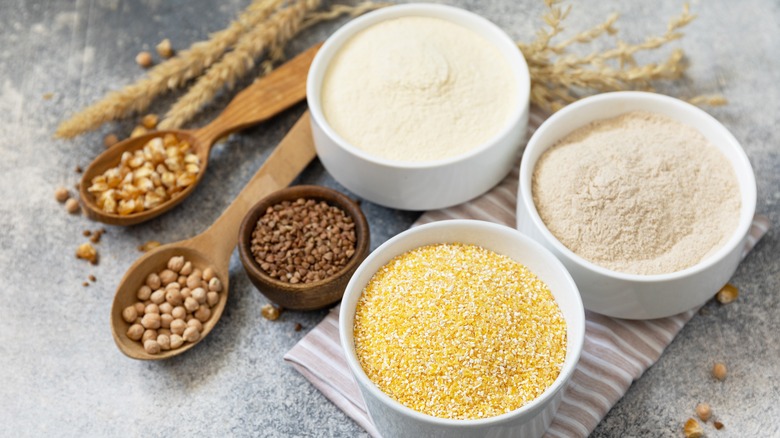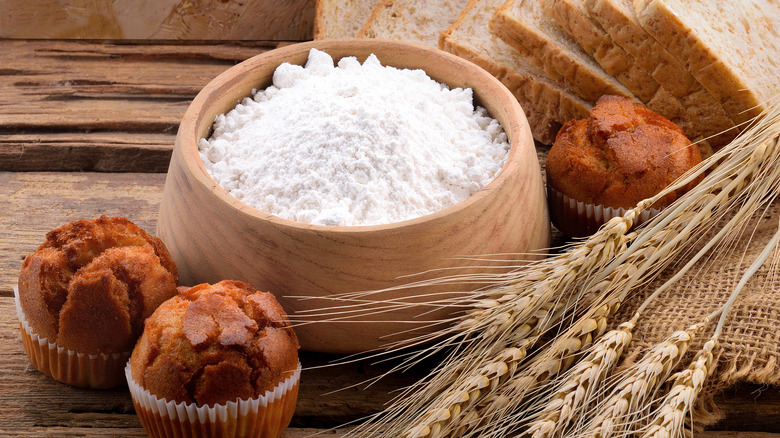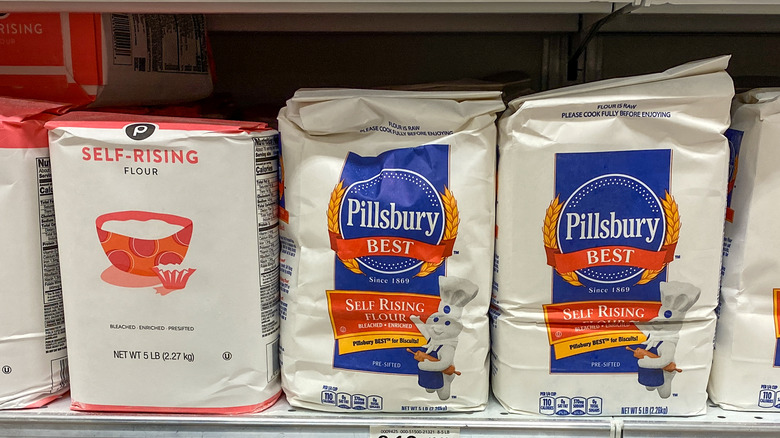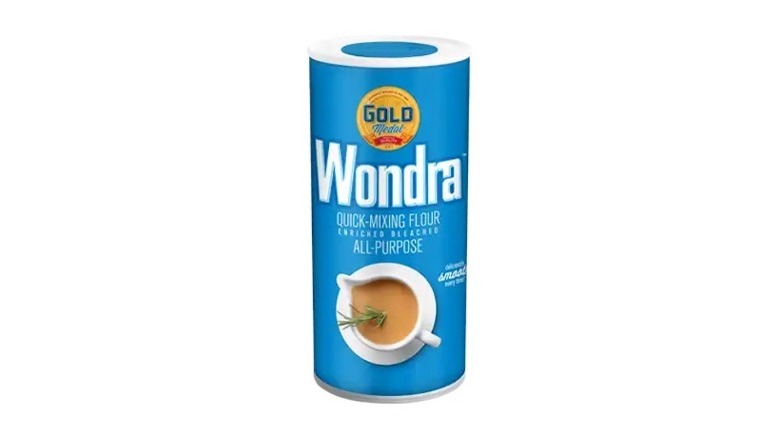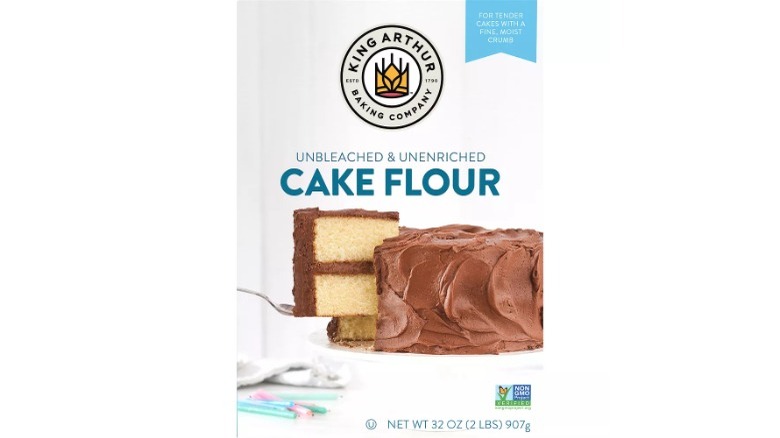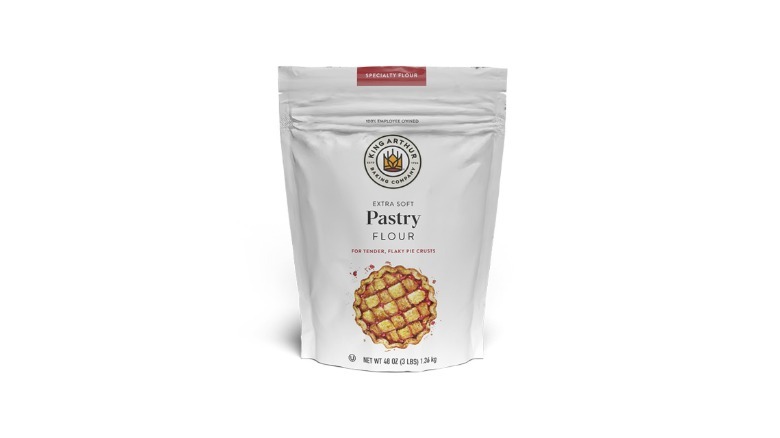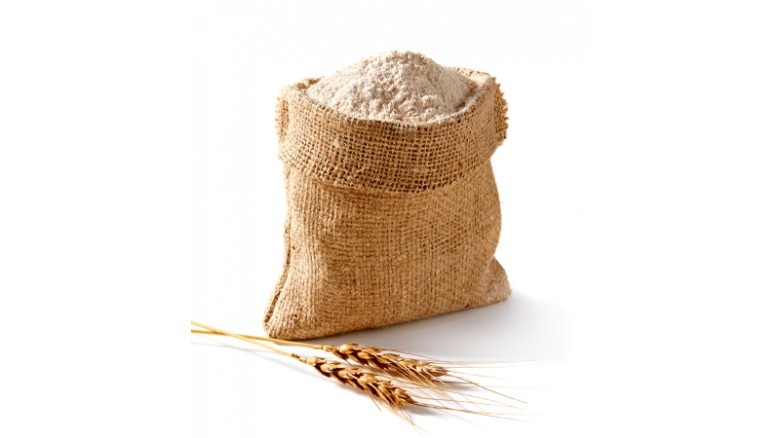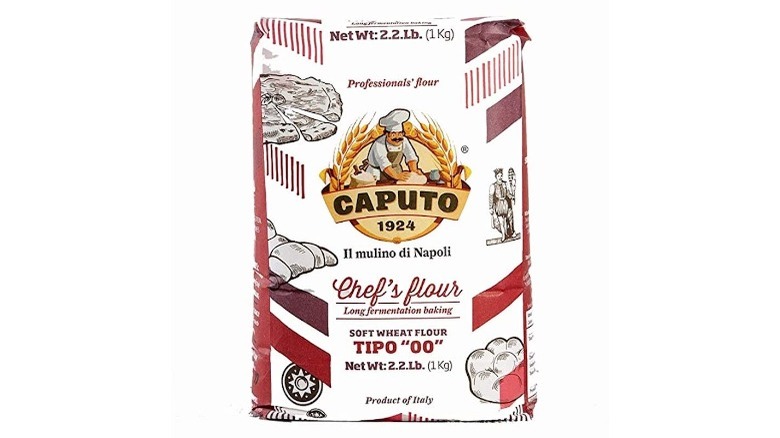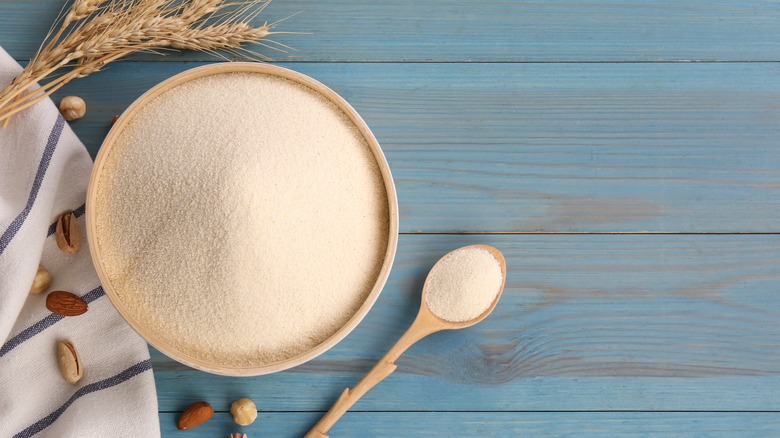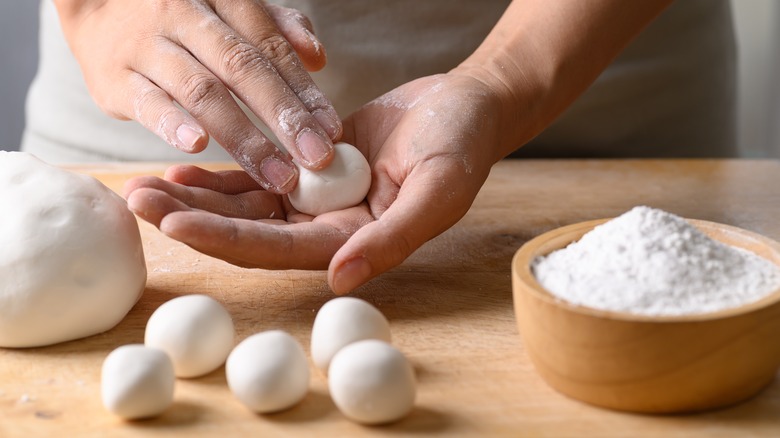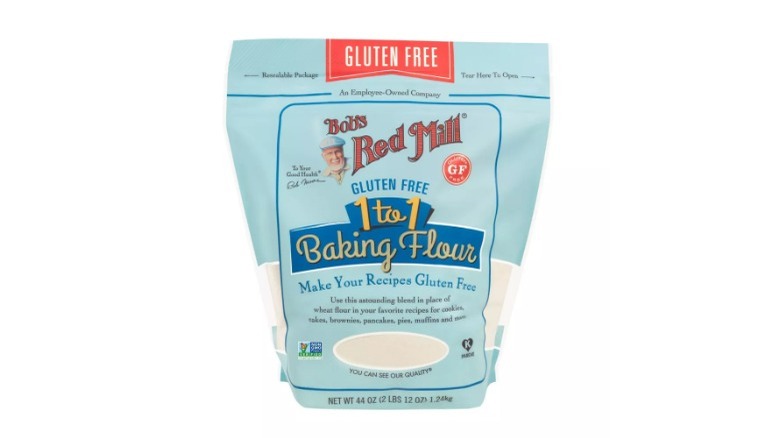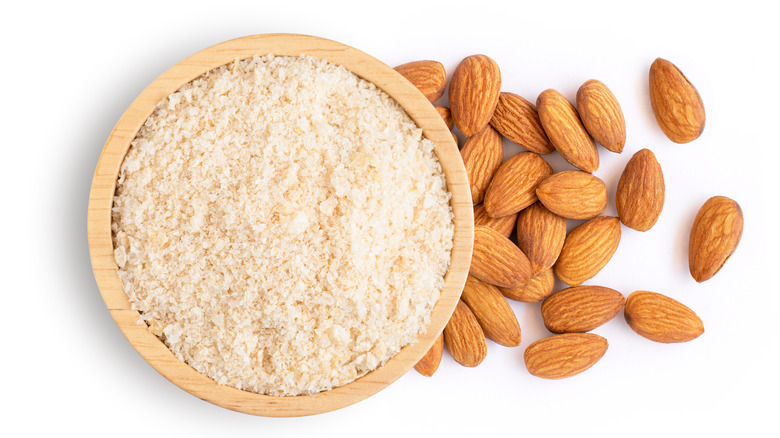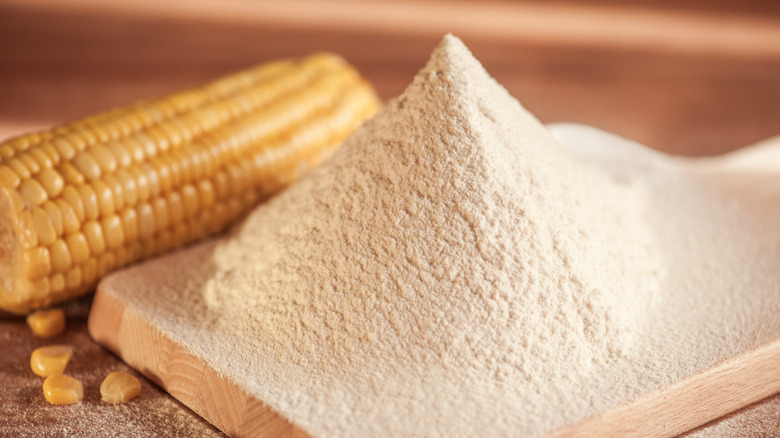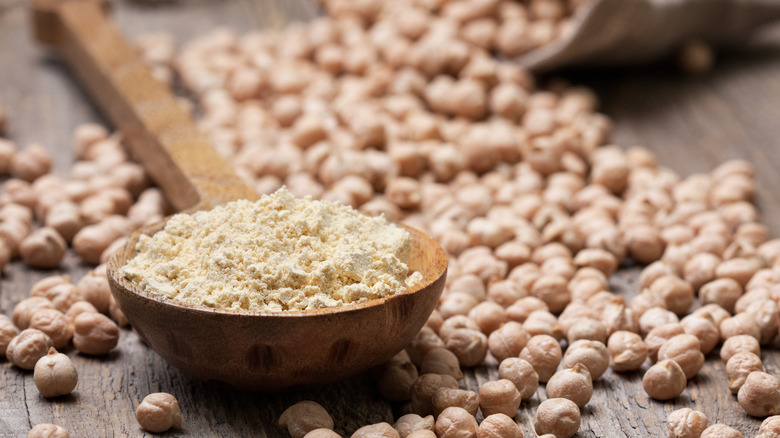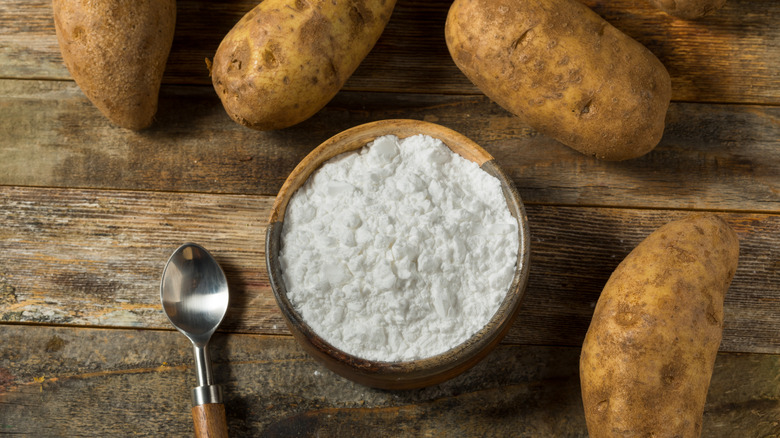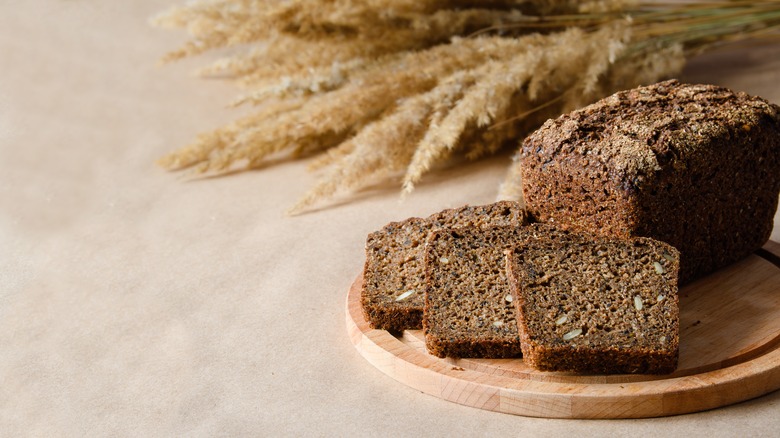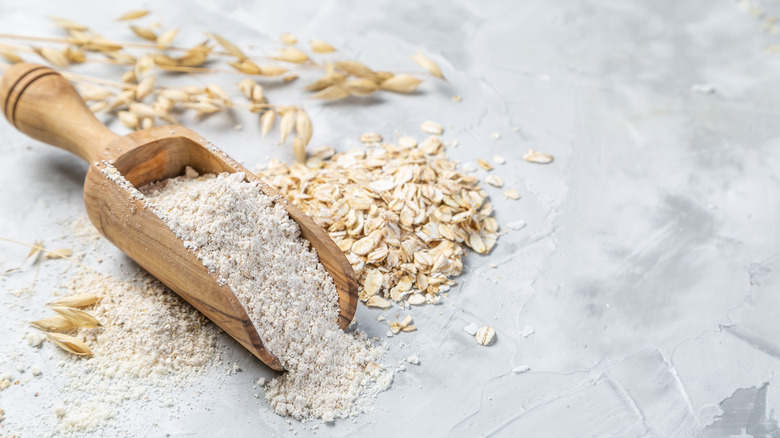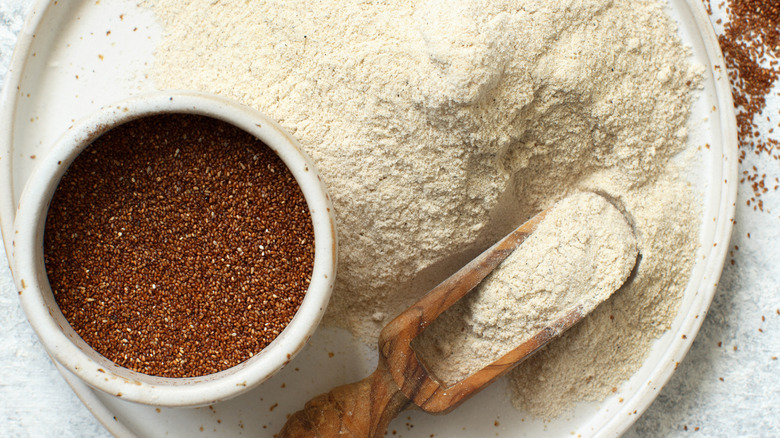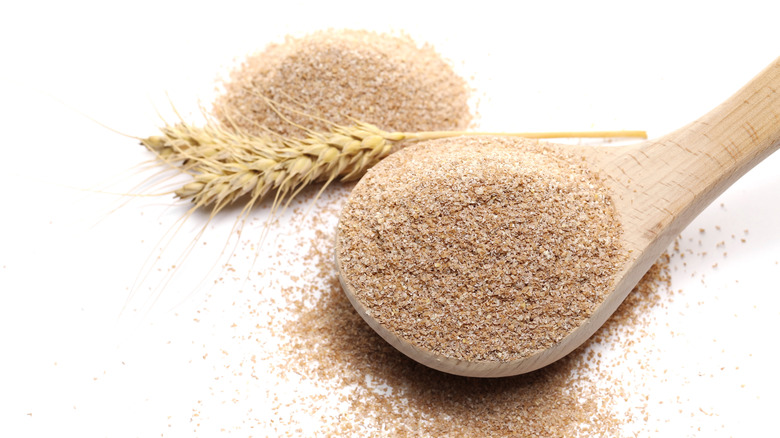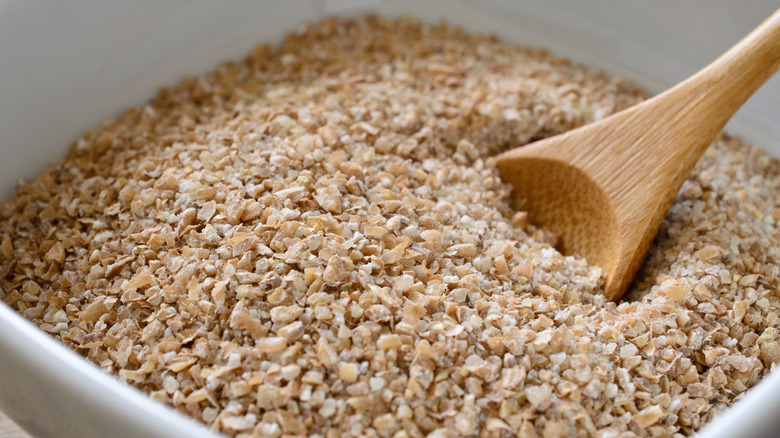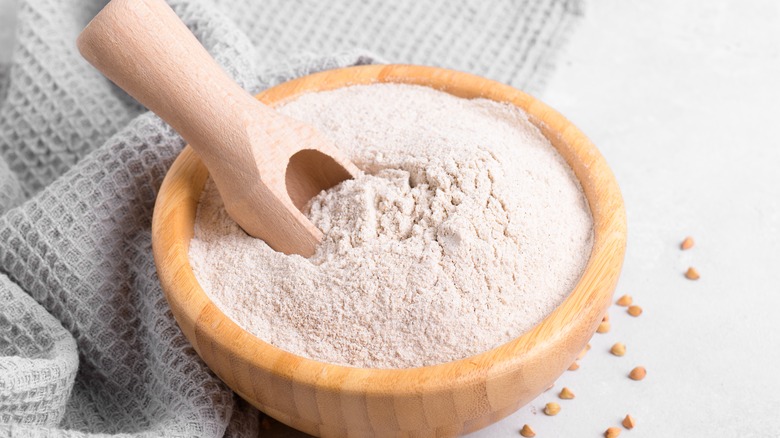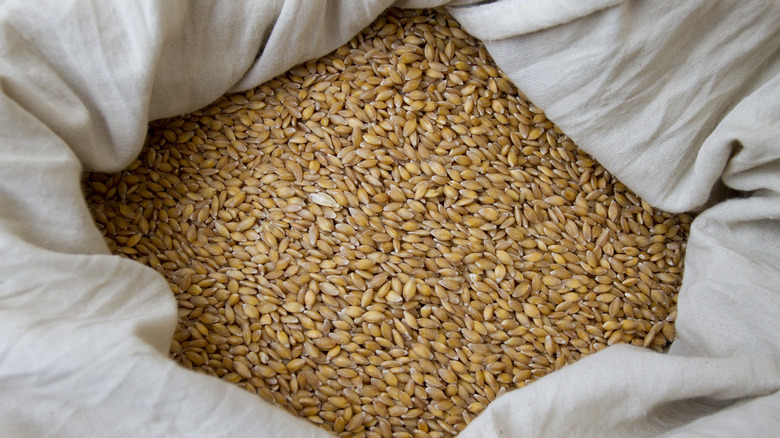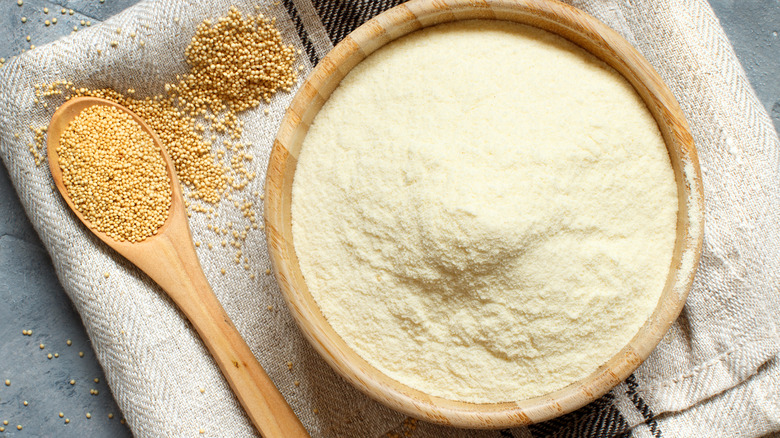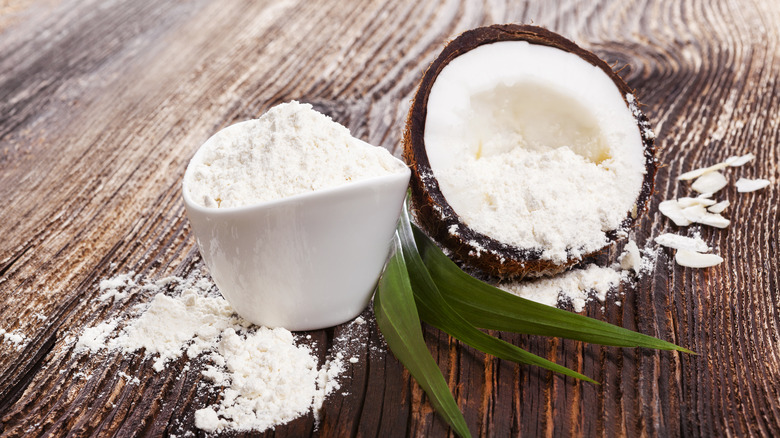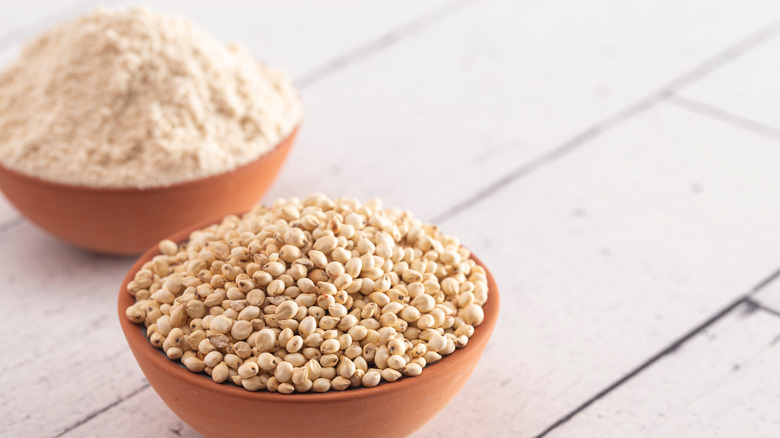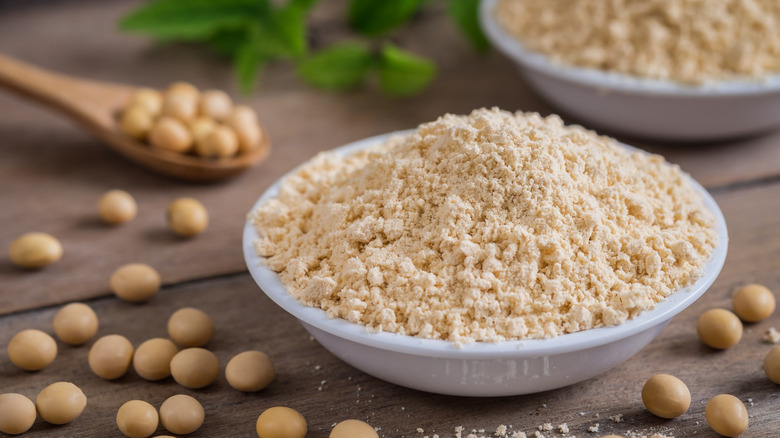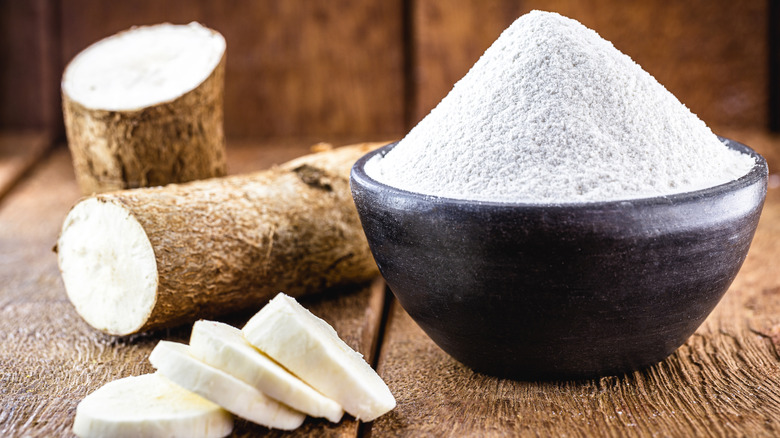27 Types Of Flour And How To Use Them
Flour is a staple ingredient in any kitchen. We use it for everything from baking bread and pastries to thickening roux and coating fried foods. That being said, flour is not a uniform pantry item. Take a walk down any grocery store's baking aisle and you'll quickly see the variety of flours available. The vast number of options can make it hard to figure out which flour to use, especially when recipes tell you to simply use "flour" and don't specify which one. The problem is that flours are not always interchangeable; and when they are, they may require some modification.
Flour varies based on what it is made out of, which also affects its taste and texture. Protein levels such as gluten can also vary, which may influence the final outcome (especially when it comes to baking) and can have an effect on whether someone with an allergy reacts. If you are stuck trying to find the best flour for your next baking project, look no further. We will walk you through the different flour options and when to use them.
1. All-purpose flour
All-purpose flour is perhaps the most common variety you can find in the grocery store. It is readily available, and widely used. If a recipe doesn't state otherwise, this is likely the flour that's intended for use. All-purpose flour is made using ground wheat. This kind of flour is heavily refined to remove the outer layer of the grain. All-purpose flour has a gluten content of 8-11%. The more gluten in a product, the stronger the bonds. This ends up affecting the texture of the end result. Flours with more gluten may end up tasting chewy or rubbery, while flours with less gluten may end up crumbly. All-purpose flour has a moderate level of gluten that makes it suitable for a wide range of uses. The result is soft white flour that is ideal for most cooking projects including cookie recipes, pies, and dredging.
2. Self-rising flour
Self-rising flour starts with a base of all-purpose flour but includes baking powder and salt as well. This flour can be a time and energy saver. The flour was initially invented in the 1800s for use on board ships but is now sold for home use. However, the addition of baking powder and salt means it can not be used interchangeably with regular all-purpose flour without some modifications.
Recipes that call for this kind of flour will usually state so explicitly. However, if you find a recipe that calls for self-rising and you don't have any on hand, you can make your own by adding 1 ½ teaspoons baking soda and ¼ teaspoon salt to every 1 cup of all-purpose flour.
3. Instant flour
Instant flour should not be confused with self-rising. The name does not indicate a quick rise, but instead a quick mix. Instant flour is made with a lower protein content than all-purpose, thanks to its combination of wheat and malted barley flours. In addition, it comes "pre-cooked." Whereas most flour comes raw, brands such as Wondra steam and dry the flour, which ends up helping it dissolve faster. This gives instant flour a softer texture that is not suitable for recipes that require structure, such as bread. Instead, it is an excellent choice when used as a thickener for items such as roux or gravy. It's also suitable for use in smooth batters when you want no lumps, such as crepes.
4. Bread flour
Bread flour is a strong flour. Literally. In England, it's actually called "strong flour." Bread flour has a higher gluten content than all-purpose, at between 12-14%. This higher gluten content means it forms tighter bounds and creates doughs that hold together better and become chewier than those made with all-purpose flour. As its name indicates, this makes it an excellent choice for breads and other chewy doughs like cinnamon buns. However, you can use it for different items. For example, chef Alton Brown uses it instead of all-purpose to make his ultra-chewy chocolate chip cookies.
5. Cake flour
Cake flour is the opposite of bread flour in many ways. Instead of having a high gluten content, it has a low range of 5-8%. The flour is also extra fine or "superfine" milled, which means it contains tiny granules and absorbs water better. This reduced protein content means anything baked with it will be soft and delicate, as opposed to dense and chewy. This is ideal for cakes and other baked goods that you want as light as possible.
Ideally, you shouldn't substitute other flour for cake flour; however, if you only have all-purpose flour, you can remove 2 tablespoons of all-purpose flour for every 1 cup of cake flour called for in a recipe. This will help to achieve a lighter result in the end.
6. Pastry flour
Pastry flour falls in between all-purpose flour and cake flour, with an 8-10% protein content. As a result, it's not suggested for truly delicate baked goods such as cakes, but it can make a light pastry that holds together well. It's ideal for biscuits or soft and pillowy chocolate chip cookies. It can also be used for quick bread and muffins that you want extra tender.
If you want to replicate pastry flour at home, add 2 tablespoons of cornstarch to 1 cup of all-purpose flour. This lowers the gluten content of the flour to mimic pastry flour.
7. Whole wheat flour
Whereas general all-purpose flour consists of the ground inner layer of the wheat, whole wheat flour contains the entire wheat kernel, including the bran, endosperm, and germ. The result is flour that is darker in color and typically has a noticeably coarser texture than all-purpose flour.
Even though it contains a similar gluten content of about 12-13%, whole wheat flour results in denser baked goods with a noticeably nutty flavor. This means it should be used primarily for recipes where those characteristics are beneficial, such as hearty breads or crackers.
Whole wheat flour also goes bad quicker due to the additional oil found in the bran and germ. If you substitute whole wheat flour for all-purpose, add at least 1 teaspoon of water per cup of flour as whole wheat flour absorbs more water than all-purpose.
8. Type 00 flour
Type 00 flour is the secret agent that makes the best pizza crust around. The "00" is the grind size. Flour in Europe ranges in grind size from 00 to 2, with 00 being the smallest and two being the largest. This grind size can be found in different types of wheat flour, such as whole wheat or high protein. Bread flour which is type 00 is incredibly popular for pizza. The soft flour gives an ideal texture and consistency that helps create a flavorful crust with the perfect crispy outside and chewy inside. It is the best mix of high-protein bread flour and easy-to-mix pastry flour.
9. Semolina flour
Semolina flour is flour made from durum wheat. It is noticeably coarser and often darker in color than all-purpose flour and has an earthy aroma. Semolina flour is also high in gluten. This high gluten content makes it ideal for its most popular use — pasta. It helps hold noodles together, allowing them to take shape and stand up to boiling without turning into sludge. That is why semolina is so prevalent in Italy. In addition to pasta, semolina flour can be used to make dishes like semolina pudding.
If you need a substitute for semolina, bread flour is ideal due to its high gluten content.
10. Glutinous rice flour
Do not be fooled by the name. Glutinous rice flour does not actually contain any gluten in it. Instead, it gets this moniker from the starches that help hold it together. Glutinous rice flour is made with sticky rice that has been cooked, dried, and ground into powder. The result is a gluten-free flour that has a lot of hold to it.
Glutinous rice flour is used traditionally in many Asian dishes. It is the base for mochi and can be used to make the popular drink, boba tea. It can also be used to make dumplings or as a gluten-free thickening agent. It is also utilized in many gluten-free baking mixes.
11. Gluten-free flour blends
There are a lot of gluten-free types of flour available, but you may have noticed packages of seemingly generically labeled gluten-free flour. These are mixes made by different brands that are designed to be substituted for gluten-containing flour, such as all-purpose flour. Brands do this by blending gluten-free flours, such as rice or garbanzo flour, with starch and additives, such as xanthan gum. This combination produces a flour that mimics the texture and hold of a specific flour.
Because baking needs differ based on what you are making, be sure to read the label of any blend. For example, some are not suitable for yeast-risen dough, whereas others may not work for cakes. If you want to make your recipe gluten-free, pick a blend made for your project.
12. Almond flour
Flour does not have to be made from grains. Really, it can be anything ground into a powder. Case in point: almond flour. This flour is simply made of ground-up almonds. Before the almonds are ground, though, they are blanched and have their skins removed. The result is a smooth, fine flour that is lightly sweet and nutty.
Almond flour is naturally gluten-free and low in carbs. This means many people choose it as a flour alternative due to diet preferences or restrictions. But it is not a simple wheat flour substitute — while you can use it in almost any baking project, the lack of gluten tends to result in "flatter" bakes that are denser in texture. Almond flour is the traditional flour for baked goods such as macarons and almond-flavored cookies. It is also a key component of marzipan.
13. Corn flour
There are lots of ground-up corn-based products out there. Don't get confused, though — corn flour is not the same as cornstarch or cornmeal. Corn flour is made by grinding dried corn into a fine, smooth powder. Cornmeal, on the other hand, is much coarser and is the basis for dishes such as grits and polenta. Cornstarch is made from just the endosperm of the corn kernel and is typically used as a thickener.
As a naturally gluten-free choice, corn flour can be used as a gluten-free alternative when coating and frying food. The flour gets ultra-crisp and has a light corn flavor to it. It can also be used to make things such as cornbread or corn pancakes. It doesn't work as a one-to-one substitute for all-purpose flour, though.
14. Chickpea flour
Chickpea flour, also known as garbanzo bean flour, is flour made from chickpeas. That's right, that bean that makes your favorite snack — hummus — also makes flour. Chickpea flour is naturally gluten-free but has the added benefit of protein, vitamins, and added fiber not found in wheat flour.
Chickpea flour is used to make Indian dishes such as pakora and laddu and works as an excellent alternative to wheat flour when frying. When mixed with wheat flour, it can make many of your favorite baked goods while maintaining texture and adding its own health benefits.
15. Potato flour
In the world of food, there are few items more versatile than potatoes. So it should come as no surprise that this fantastic tuber can also make soft flour. To make potato flour, the potatoes are cooked, dehydrated, and ground into a fine powder that's naturally gluten-free. This is different from potato starch, which has the starch extracted from the potato.
Potato flour can be a helpful flour to add to your arsenal. The high starch content means it can make a crisp coating. Adding it to recipes such as cinnamon buns can elevate the final result and provide an extra tender feel. The flavor offers a mild potato note, but it's not intrusive.
16. Rye flour
Wheat is not the only grain used to make flour. Of the wheat alternatives, rye is fairly common, being one of the critical components in baked goods like rye bread. There are different types of rye flour, starting with white rye and progressing to dark rye. The different kinds affect the taste, color, and texture of the final product. White rye, or "light rye," is mild and has the softest texture. Medium rye is a middling version that's darker and denser. Finally, dark rye is the deepest in color and flavor. One classic rye dish — pumpernickel — uses dark rye flour to elicit the earthy and spicy pumpernickel flavor.
Rye flour can be used in place of some or all of the all-purpose flour in recipes. It is particularly good when paired with heavily spiced foods such as gingerbread, as they already have a warm flavor.
17. Oat flour
Oat flour is made by grinding oats into a fine powder. While this flour can not be used to replace wheat flour in most recipes, it has its uses. Oat flour can act as a binder in place of wheat flour items such as meatballs and veggie burgers. Oats are naturally gluten-free, which makes them a great alternative to wheat-based products.
Oat flour clearly has an oat flavor, but if an oat milk latte doesn't bother you, using oat flour in your cooking won't bother you, either. In addition to acting as a binder, it makes a great addition to pancakes or muffins and can work as part of a crumble or crisp topping. Not only that, it is easy to make by simply throwing uncooked oatmeal in a food processor and grinding it until it's very fine.
18. Teff flour
Teff is a grain that dates back thousands of years to the Ethiopian and Eritrean regions in Africa. Teff is the smallest grain and resembles millet. While not common in the United States, teff makes a fantastic and versatile flour that's naturally gluten-free. Teff comes in a selection of colors, including brown, white, and red. Each makes its own flour. White, or ivory teff, has a mild flavor, whereas brown teff offers a nutty and deeper flavor.
Teff is the main ingredient in the Ethiopian pancake bread injera. However, it can be used to make other things such as gluten-free cookies and pancakes. If you are looking for a subtle flavor, stick with ivory teff flour, but if you want to experiment with a richer flavor, opt for brown.
19. Spelt flour
Spelt is a type of ancient wheat. It has been grown for thousands of years and is known as dinkel wheat. Because it is a kind of wheat, it should come as no surprise that spelt does contain gluten. However, there are some reasons you might decide to use spelt flour instead of regular all-purpose.
Whole grain spelt flour is high in protein and fiber and has a lower glycemic index than all-purpose flour, which means it affects blood sugar levels to a lesser degree. It also tends to help with digestion due to its high fiber content. Generally speaking, you can use spelt flour in place of standard all-purpose or whole wheat flour without much issue.
20. Graham flour
If the name rings a bell, that's probably because graham flour is the flour used to make graham crackers. Named after Reverend Sylvester Graham, graham flour is basically whole wheat flour kicked up a notch.
Graham flour contains every part of the wheat berry, which means yes, it does have gluten in it. The endosperm, the part typically used to make all-purpose flour, is ground into a fine powder while the germ and bran are ground more coarsely. Then, the three components are mixed together. The flour was originally created to make its namesake cracker, but it can also be used for cookies, scones, or anything else you want a denser "graham" texture for.
21. Buckwheat flour
Buckwheat, despite the name, is not a kind of wheat. It's not even a true grain. It's what's termed a "pseudo-grain" because it "acts" like a grain, but is actually a seed ... and in this case, it's the seed of an herb. The flour is made by grinding the buckwheat seed into a fine powder. The end result is a flour full of protein and fiber, but no gluten.
Because buckwheat is actually an herb, it shouldn't be surprising that it has a discernible flavor. It's bitter and earthy tasting, which lends itself to some baked goods, but not others. Pancakes are a popular food that can be made with buckwheat, as are classic Japanese soba noodles.
22. Einkorn flour
Einkorn is a type of wheat, so it does contain gluten. However, einkorn is an ancient grain and is naturally lower in gluten than the more common varieties used to make standard wheat flour. It's also lower in carbohydrates, which may make it a good choice for people limiting their carbohydrate intake.
Since it's wheat flour, einkorn can be used in place of all-purpose flour for many things. Einkorn flour offers a soft texture, perfect for making crumbly baked goods such as muffins, cakes, and soft cookies, but it can be used in anything that calls for wheat flour. Additionally, the flour has an interesting pale yellow color which doesn't profoundly affect the final result of bakes.
23. Amaranth flour
Amaranth is another type of "pseudo-cereal" or "pseudo-grain." It's not a grain but a perennial plant from the Americas that produces a grain-like seed that is ground to make flour. Amaranth flour is high in protein and fiber and is naturally gluten-free. This means it's a good choice for people who have gluten sensitivities or allergies, or who simply want to boost their fiber intake.
Amaranth flour is particularly good for making flatbread. It does not typically work on its own as a straight substitute for wheat-based flour, as it doesn't rise as easily. However, it can be combined with wheat flour to add fiber and protein to items such as bread.
24. Coconut flour
Coconut flour adds a tropical flavor to whatever you use it in. It's made from the meat of the coconut, which is dried and ground into a fine powder. Coconut flour is a common gluten-free substitute for all-purpose wheat flour. Coconut flour is higher in fat, protein, iron, and fiber than wheat flour. Plus, as an added sustainability bonus, coconut flour is a byproduct of making coconut milk.
Coconut flour is a great flour alternative for baked goods such as cookies and muffins. However, it holds more liquid than wheat flour, so you may need to adjust recipes accordingly. Additionally, it doesn't offer the same hold as wheat flour due to its lack of gluten, so it's not ideal for making bread.
25. Sorghum flour
Sorghum is a cereal grain but is not a kind of wheat. As such, it's also naturally gluten-free, like other non-wheat cereal grains. Sorghum also contains more protein, vitamins, and minerals than standard wheat flour. For these reasons, you may want to use sorghum in place of its more common cousin.
Sorghum flour is also commonly called jowar flour. It is light and fluffy and has a mild flavor that is non-intrusive. It is used to make jowar roti, an Indian flatbread. Sorghum can make a good gluten-free alternative to whole wheat flour and offers a slightly sweeter flavor. It can also be paired with starches and gums to create a gluten-free flour alternative.
26. Soy flour
Soy flour is made by taking hulled soybeans and grinding them into a fine, high-protein powder. Like other products made from soy, such as soy milk and tofu, the flavor is distinctly nutty and earthy. While soybeans are naturally gluten-free, some of their best uses are in conjunction with wheat flour. Added to wheat flour, soy flour can boost protein levels, offer a beautiful brown crust to bread, and generally make dough easier to work with.
Soy flour can also act as a thickener for sauces, can be used to coat food when frying, and can be used to make non-yeasted baked goods. It can even be used as an egg substitute in baked goods when mixed with water.
27. Tapioca flour
Tapioca flour is made from the cassava root after it's been dried and ground, which makes it similar to potato flour. However, it's important to distinguish it from tapioca starch as the flour is made from the whole root, while tapioca starch is made from just one part. It is also distinct from cassava flour, which is made from the whole plant.
Tapioca flour can be used to create many delicious dishes. It has incredible holding power and is used as a thickener in soups and stews. It can also be used to make tapioca pudding and to make boba for bubble tea. It can also be mixed with other flours to make light and fluffy baked goods. As a gluten-free alternative, it has an incredible hold and can be used as a wheat flour substitute.
